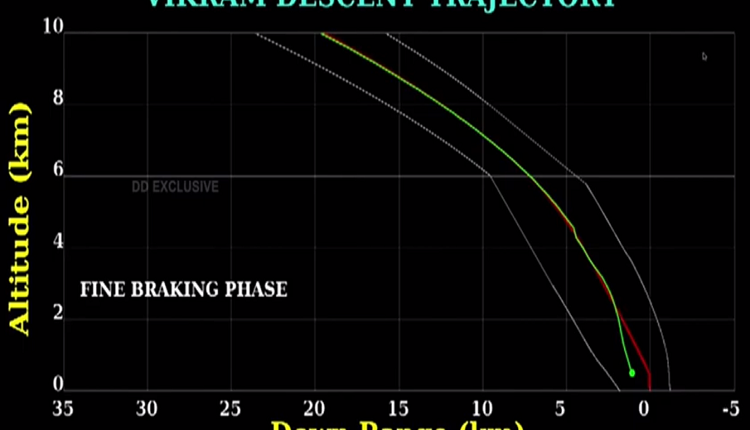Chandrayaan 2 – India’s pride
Written by Dr Mila Mitra, Co-founder and Chief Scientific Officer, STEM & Space
‘Space is hard, no success without failure’, the famous science communicator Neil De Grasse Tyson commented after the Vikram lander stopped communicating.
All of India was waiting with a high level of excitement for the climax of Chandrayaan-2 lander’s soft landing on the moon on September 7. Unfortunately, things went wrong at the very end specifically at the last 2 km point, leaving the whole nation disappointed but standing in solidarity with ISRO. But what really happened? Will the mission still be able to contribute?
Chandrayaan-2 consisted of three major components – an orbiter which was designed to keep orbiting around the moon for a year and carry out studies of the moon from that distance, a lander called Vikram which would do a soft touch down on the lunar surface and carry a couple of payloads which would measure surface parameters, and it would also carry a rover ‘Pragyaan’ which was scheduled to roll out a few hours later and do its own in situ measurements. The lander and rover would have worked only for 14 days, during a Lunar Day. This mission had aimed to confirm the findings of its predecessor, Chandrayaan-1 which had found water ice on the moon. This is why the lander was aiming to land close to the moon’s unexplored South Pole, as the permanently shadowed areas there can harbour ice and minerals in the craters.
READ ALSO: Seven life-lessons for students from ISRO’s Chandrayaan-2 setback
A critical part of the mission was ‘soft’ landing the lander on the lunar soil, which would have made India only the fourth country to achieve this, after USA, Russia and China. But this ‘soft’ landing was fraught with challenges, as the trajectory of the lander would have to be carefully guided for it to land upright and the rocket engine thrusters would have to control its own deceleration from a high speed to close to zero, as in the absence of an atmosphere, one cannot use parachutes. Additionally, in the last ‘15 minutes of terror’ as Dr Sivan, head of ISRO termed it, the lander would have to land autonomously without external support. Its autonomous system should have kicked in for it to scan for obstacles and land in a smooth location. However, as the live view showed, in the final moments the path veered away sharply from the planned trajectory. That is when ISRO lost communication with the lander. After about 24 hours, the lander has now been spotted by the orbiter’s thermal cameras, seemingly intact but tilted over, and ISRO has been trying to regain communication between the lander.
Does it mean the mission has failed?
Moon missions are tricky and many have failed. Out of 109 lunar missions since 1958, only 61 were successful. Of the 46 missions that involved landing on the moon, only 21 were successful. The first successful sample return mission was Apollo 12, a US launched mission in 1969. Most recently, Israels’ Beresheet had also landed in April, when the engines designed to slow down the descent, failed.
Although ISRO didn’t manage the big two challenges of the soft landing and deployment of a rover, the mission has had many successes and is being lauded worldwide for the technical prowess it has displayed. In fact, it is being hailed as ‘95%’ successful! What were the successes? The GSLV Mark III successfully launched the rocket, proving the capability for such launches. The orbital maneuvers and trans-lunar orbit injection, which use the earth’s gravity as assist and take a longer time, but was instrumental in cutting down the project’s cost drastically in comparison to moon missions from other countries, all went perfectly according to plan.
READ ALSO: Five inspirational takeaways from PM Modi’s speech at ISRO
The Orbiter is safely in lunar orbit and will be carrying out experiments exploring the moon, from a 100k orbit. Most of the payloads, that is, eight scientific payloads, are on the orbiter. These will map the lunar surface and study the outer atmosphere of the moon. Dr Sivan has announced that the life of the orbiter will stretch to about seven years, instead of one! A bit more about the payloads – the orbiter high resolution camera will photograph the lunar surface to the best resolution of any lunar mission so far (0.3 m). In fact, it supported the lander by locating obstacles in the location prior to separation. The terrain mapping camera2 will map the lunar surface in multiple colours to create 3D images. The Large Area Soft X Ray Spectrometer (CLASS) will measure the spectra in XRays to look for the presence of elements and minerals. The IIRS will look for water and minerals at the sub surface level at very high resolution. The dual frequency synthetic aperture radar will also do high resolution mapping, water estimation and regolith thickness measurements at the polar region. The lunar atmosphere will also be studied.
Therefore, Chandrayaan-2 is largely a success, as its scientific goals can be largely pursued. We look forward to finding out a lot more about the moon and its atmosphere in time for Chandrayaan-3, now being planned for 2023-2024. Meanwhile, all of India lauds ISRO for the successes that this mission has already achieved despite great odds.
DISCLAIMER: Views expressed above are that of the author and do not reflect the views of the website. The Peeper Times does not assume any responsibility or liability for the same.
Do you feel strongly about something? Have a story to share? Write to us at info@thepeepertimes.com or connect with us on Facebook or Twitter




Comments are closed, but trackbacks and pingbacks are open.